有关供应链的知识汇集(英文版)
- 格式:pptx
- 大小:3.16 MB
- 文档页数:21
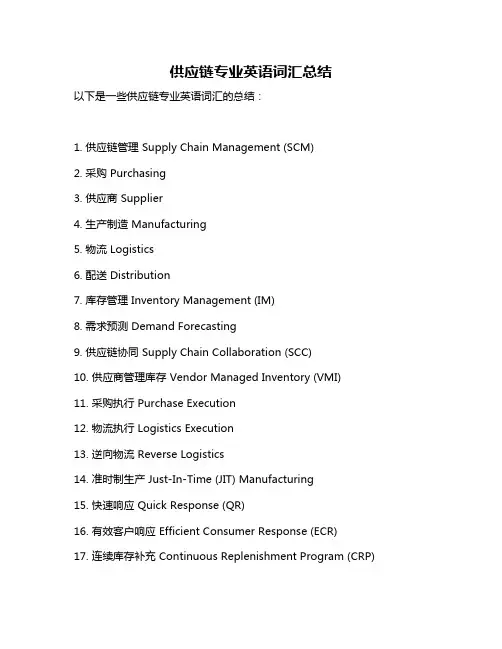
供应链专业英语词汇总结以下是一些供应链专业英语词汇的总结:1. 供应链管理 Supply Chain Management (SCM)2. 采购 Purchasing3. 供应商 Supplier4. 生产制造 Manufacturing5. 物流 Logistics6. 配送 Distribution7. 库存管理 Inventory Management (IM)8. 需求预测 Demand Forecasting9. 供应链协同 Supply Chain Collaboration (SCC)10. 供应商管理库存 Vendor Managed Inventory (VMI)11. 采购执行 Purchase Execution12. 物流执行 Logistics Execution13. 逆向物流 Reverse Logistics14. 准时制生产 Just-In-Time (JIT) Manufacturing15. 快速响应 Quick Response (QR)16. 有效客户响应 Efficient Consumer Response (ECR)17. 连续库存补充 Continuous Replenishment Program (CRP)18. 电子数据交换 Electronic Data Interchange (EDI)19. 全球定位系统 Global Positioning System (GPS)20. 射频识别技术 Radio Frequency Identification (RFID)21. 自动化仓库 Automated Warehouse22. 高级计划与排程 Advanced Planning and Scheduling (APS)23. 企业资源规划 Enterprise Resource Planning (ERP)24. 客户关系管理 Customer Relationship Management (CRM)25. 电子采购 e-Procurement26. 供应链风险管理 Supply Chain Risk Management (SCRM)27. 精益供应链管理 Lean Supply Chain Management (LSCM)28. 环境可持续供应链管理 Environmentally Sustainable Supply Chain Management (ESSCM)29. 社会可持续供应链管理 Socially Sustainable Supply Chain Management (SSSCM)30. 可持续供应链管理 Sustainable Supply Chain Management (SSCM)31. 供应商评价 Supplier Evaluation32. 采购谈判 Purchasing Negotiation33. 供应链绩效评估 Supply Chain Performance Evaluation (SCPE)34. 总成本分析 Total Cost Analysis (TCA)35. 总持有成本 Total Cost of Ownership (TCO)36. 经济订货量模型 Economic Order Quantity Model (EOQ)37. 安全库存 Safety Stock38. 采购周期 Purchasing Cycle39. 供应链网络 Supply Chain Network40. 多供应商 Multi-supplier41. 多配送中心 Multi-distribution Center42. 库存周转率 Inventory Turnover Rate43. 在途库存 In-transit Inventory44. 在途货物 In-transit Cargo45. 在途车辆 In-transit Vehicle46. 在途订单 In-transit Order47. 在途发票 In-transit Invoice。
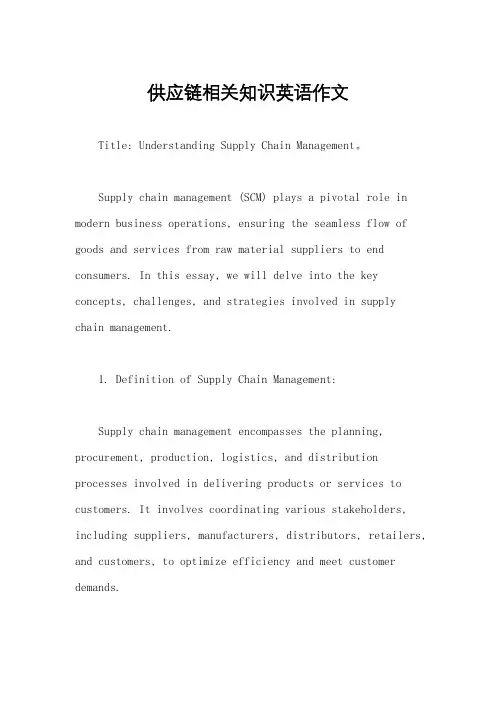
供应链相关知识英语作文Title: Understanding Supply Chain Management。
Supply chain management (SCM) plays a pivotal role in modern business operations, ensuring the seamless flow of goods and services from raw material suppliers to end consumers. In this essay, we will delve into the key concepts, challenges, and strategies involved in supply chain management.1. Definition of Supply Chain Management:Supply chain management encompasses the planning, procurement, production, logistics, and distribution processes involved in delivering products or services to customers. It involves coordinating various stakeholders, including suppliers, manufacturers, distributors, retailers, and customers, to optimize efficiency and meet customer demands.2. Key Components of Supply Chain Management:a. Procurement: This involves sourcing raw materials, components, or services from suppliers at the right price, quality, and quantity.b. Production: Once materials are procured, they are transformed into finished products through manufacturing processes.c. Logistics: Logistics involves the movement and storage of goods from production facilities to distribution centers and ultimately to customers.d. Distribution: Distribution entails delivering products to retailers or directly to end consumers through various channels, such as wholesalers, warehouses, or e-commerce platforms.e. Inventory Management: Effective inventory management ensures the right amount of stock is maintained to meet demand while minimizing excess inventory and associatedcosts.f. Information Systems: Information systems, such as Enterprise Resource Planning (ERP) systems and supply chain management software, facilitate communication and coordination among supply chain partners.3. Challenges in Supply Chain Management:a. Globalization: Managing supply chains across geographically dispersed locations introduces complexities related to transportation, customs regulations, andcultural differences.b. Supply Chain Disruptions: Events such as natural disasters, pandemics, or political unrest can disrupt the flow of goods and services, highlighting the importance of risk management and contingency planning.c. Demand Volatility: Fluctuations in customer demand can lead to inventory imbalances or stockouts, necessitating agile and responsive supply chain strategies.d. Supplier Reliability: Dependence on suppliers exposes organizations to risks such as supplier bankruptcies, quality issues, or supply shortages.e. Environmental Sustainability: Increasing pressure to reduce carbon footprint and adopt sustainable practices throughout the supply chain requires organizations to rethink sourcing, production, and distribution processes.4. Strategies for Effective Supply Chain Management:a. Collaboration: Foster collaboration and transparency among supply chain partners to improve communication, share information, and jointly address challenges.b. Inventory Optimization: Employ advanced forecasting techniques and inventory optimization models to minimize excess inventory while ensuring product availability.c. Risk Management: Develop risk mitigation strategies, such as dual sourcing, inventory buffers, or businesscontinuity plans, to mitigate the impact of supply chain disruptions.d. Technology Adoption: Embrace digital technologies such as IoT, blockchain, and artificial intelligence to enhance visibility, traceability, and efficiency across the supply chain.e. Sustainable Practices: Integrate environmental sustainability into supply chain operations by optimizing transportation routes, reducing packaging waste, and sourcing from eco-friendly suppliers.5. Conclusion:In conclusion, supply chain management is a multifaceted discipline that requires careful planning, coordination, and adaptation to navigate the complexities of today's global business environment. By understanding the key components, challenges, and strategies of supply chain management, organizations can enhance theircompetitiveness, resilience, and sustainability in an ever-evolving marketplace.。
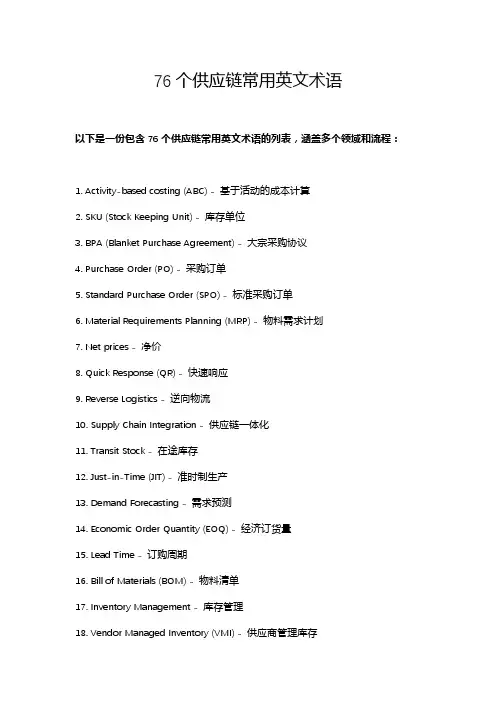
76个供应链常用英文术语以下是一份包含76个供应链常用英文术语的列表,涵盖多个领域和流程:1. Activity-based costing (ABC) - 基于活动的成本计算2. SKU (Stock Keeping Unit) - 库存单位3. BPA (Blanket Purchase Agreement) - 大宗采购协议4. Purchase Order (PO) - 采购订单5. Standard Purchase Order (SPO) - 标准采购订单6. Material Requirements Planning (MRP) - 物料需求计划7. Net prices - 净价8. Quick Response (QR) - 快速响应9. Reverse Logistics - 逆向物流10. Supply Chain Integration - 供应链一体化11. Transit Stock - 在途库存12. Just-in-Time (JIT) - 准时制生产13. Demand Forecasting - 需求预测14. Economic Order Quantity (EOQ) - 经济订货量15. Lead Time - 订购周期16. Bill of Materials (BOM) - 物料清单17. Inventory Management - 库存管理18. Vendor Managed Inventory (VMI) - 供应商管理库存19. Distribution Center (DC) - 分销中心20. Transportation Management System (TMS) - 运输管理系统21. Enterprise Resource Planning (ERP) - 企业资源规划22. Third-Party Logistics (3PL) - 第三方物流23. Fourth-Party Logistics (4PL) - 第四方物流24. Finished Goods Inventory - 成品库存25. Work in Process (WIP) - 在制品26. Cycle Counting - 循环盘点27. Cost of Goods Sold (COGS) - 销售成本28. Freight Forwarder - 货运代理29. Incoterms - 国际贸易术语解释通则30. Dock Scheduling - 码头调度31. Drop Shipping - 直接配送32. Pick and Pack - 拣选包装33. Cross-Docking - 越库作业34. Sales & Operations Planning (S&OP) - 销售与运营计划35. Customer Relationship Management (CRM) - 客户关系管理36. Total Quality Management (TQM) - 全面质量管理37. Supplier Relationship Management (SRM) - 供应商关系管理38. Return Merchandise Authorization (RMA) - 商品退货授权39. Barcode / QR Code - 条形码/二维码40. Hazardous Materials (HazMat) Handling - 危险品处理41. Cold Chain - 冷链物流42. Lean Manufacturing - 精益生产43. Six Sigma - 六西格玛44. KPIs (Key Performance Indicators) - 关键绩效指标45. Port of Origin - 起运港46. Port of Destination - 目的港47. Customs Clearance - 海关清关48. Free On Board (FOB) - 船上交货49. Cost, Insurance, and Freight (CIF) - 成本、保险费加运费50. Delivered Duty Paid (DDP) - 完税后交货51. Ex Works (EXW) - 工厂交货价52. Inbound Logistics - 入库物流53. Outbound Logistics - 出库物流54. Order-to-Cash (OTC) - 订单到收款55. Procure-to-Pay (P2P) - 采购到付款56. Global Trade Management (GTM) - 全球贸易管理57. EDI (Electronic Data Interchange) - 电子数据交换58. Takt Time - 节拍时间59. Kanban - 看板管理60. FIFO (First In, First Out) - 先进先出61. LIFO (Last In, First Out) - 后进先出62. Safety Stock - 安全库存63. Lot Size - 批量大小64. Containerization - 集装箱化65. MRP II (Manufacturing Resource Planning) - 制造资源计划66. DRP (Distribution Resource Planning) - 分销资源计划67. Drop Trailer Program - 拖车卸货计划68. Consolidation - 集拼69. Deconsolidation - 拆箱分拨70. Value-Added Services (VAS) - 增值服务71. Trade Compliance - 贸易合规72. Shipment Tracking - 运输追踪73. Carrier Selection - 承运商选择74. Multi-modal Transport - 多式联运75. Green Supply Chain - 绿色供应链76. Blockchain Technology - 区块链技术(在供应链中的应用)请注意,这并非一个详尽无遗的列表,但涵盖了供应链管理中广泛使用的许多关键术语。
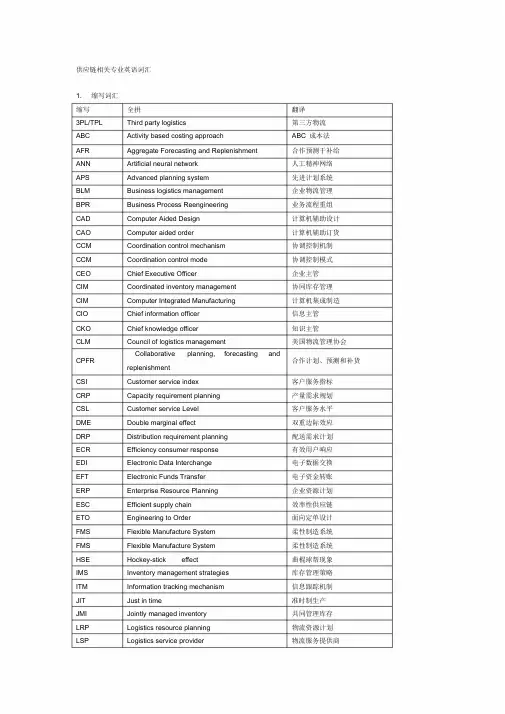
供应链相关专业英语词汇1. 缩写词汇缩写全拼翻译3PL/TPL Third party logistics 第三方物流ABC Activity based costing approach ABC 成本法AFR Aggregate Forecasting and Replenishment 合作预测于补给ANN Artificial neural network 人工精神网络APS Advanced planning system 先进计划系统BLM Business logistics management 企业物流管理BPR Business Process Reengineering 业务流程重组CAD Computer Aided Design 计算机辅助设计CAO Computer aided order 计算机辅助订货CCM Coordination control mechanism 协调控制机制CCM Coordination control mode 协调控制模式CEO Chief Executive Officer 企业主管CIM Coordinated inventory management 协同库存管理CIM Computer Integrated Manufacturing 计算机集成制造CIO Chief information officer 信息主管CKO Chief knowledge officer 知识主管CLM Council of logistics management 美国物流管理协会CPFRCollaborative planning, forecasting andreplenishment合作计划、预测和补货CSI Customer service index 客户服务指标CRP Capacity requirement planning 产量需求规划CSL Customer service Level 客户服务水平DME Double marginal effect 双重边际效应DRP Distribution requirement planning 配送需求计划ECR Efficiency consumer response 有效用户响应EDI Electronic Data Interchange 电子数据交换EFT Electronic Funds Transfer 电子资金转账ERP Enterprise Resource Planning 企业资源计划ESC Efficient supply chain 效率性供应链ETO Engineering to Order 面向定单设计FMS Flexible Manufacture System 柔性制造系统FMS Flexible Manufacture System 柔性制造系统HSE Hockey-stick effect 曲棍球帮现象IMS Inventory management strategies 库存管理策略ITM Information tracking mechanism 信息跟踪机制JIT Just in time 准时制生产JMI Jointly managed inventory 共同管理库存LRP Logistics resource planning 物流资源计划LSP Logistics service provider 物流服务提供商MIS Measuring index system 评价指标体系MPS master production scheduling 主生产排程MRP Material Requirement Planning 物料需求计划MRP ⅡManufacturing Resource Planning 制造资源计划MTO Make to order 按订单生产MTS Make to stock 备货生产NSM Negotiation selection method 协商选择法OEM Original equipment manufacturer 原始设备制造商POS Point of sale 销售终端QFD Quality function development 质量功能开发RSC Responsive supply chain 响应性供应链RSC Revenue sharing contracts 收益共享契约RCCP rough-cut capacity planning 粗能力计划SCC Supply chain coordination 供应链协调SCD Supply chain design 供应链设计SCM Supply chain management 供应链管理SCN Supply chain network 供应链网络SCP Supply chain planning 供应链计划SCP Supply chain partnership 供应链合作关系SFA Sales Forecast Accuracy 预测准确率SKU Stock Keeping Unit 库存进出计量的单位SI Sell in 销售进入渠道SO Sell out 销售给消费者SRM Supplier relationship management 供应商关系管理S&OP Sales and operation planning 销售运营计划TOC Theory of constraint 约束理论TPM Traditional purchase mode 传统采购模式TMS Transportation management system 运输管理系统VMI Vendor Managed Inventory 供应商管理库存WMAPE Weighted Mean Percentage Error 加权平均绝对百分比误差WMS Warehouse management system 仓储管理系统2. 非缩写核心词汇ABC classification ABC 分类Accessory 附件Action Report 行动报告Aggregate Planning .总体规划Agile Manufacturing 灵活制造Allocated Inventory 保留量Alternate BOM 替代物料表Anticipation Inventory 预期库存Assemble to Order 定单组装Automation 自动化Available Inventory 可用库存Available to Promise 可答应量Backlog 待交货Back Order 逾期订单Bill of Labor 人力表BOM Bill of Material 材料表bill of resources 资源表BOM Code 材料表码Bom Explosion 材料表展开Bom Implosion 材料表逆展Bom Structure 材科表结构Built-on-the-Iine parts 线上生产零件Bulk lssue 大批发料Bullwhip Effect 长鞭效应Business Plan 事业计划Capacity 产量Capacity Control 产量控制Capacity requirement planning 产量需求规划Check-in 结入Check-Out 结出Common part Bom 共享件材料表constraint management 限制因素管理continuous production 连续式生产critical capacity 关键产量critical part 关键零件customer order 客户定单customization 客制化customer service level 顾客服务水准cycle count interval 周期盘点区间cycle counting 周期盘点cycle time 周期时间Demand Management 需求管理demonstrated capacity 验证产量iscret manufacturing 装配式生产distribution center 配销中心distribution requirement planning 分销资源计划economic order quantity 经济订购量economic part period 经济量期emergency kanban 紧急看板finished goods 完成品firm planned order 固定计划定单first in first out 先进先出forecast 预测forecast horizon 预测期间fundamental data 基本资料gross requirement 总需求inbound queue control 输入端队列控制independent demand 独立需求input/output control 输入/输出控制intermittent production 问歇式生产inventory management 库存管理inventory status 库存状态inventory type 库存形态job 工件,工作job shop 工件生产工厂just in time 及时供补kanban 看板kanban ceiling 看板界限lead time 前置时间lead time offset 前置时问冲销least total cost 最低总成本批量法least unit cost 最低单位成本批量法level scheduling 平准化排程level production(linearity) 平准化生产linearity 定率生产load 负荷look ahead/look back 瞻前顾后法lot for lot 逐批批量法lot number 批号lot size 批量lot size inventory 批量库存lot sizing rule 批量法则maintenance, repair and operational supplies 间接物料make to order 定单生产make to stock 计划生产manufacturing bom 制造单元manufacturing cell 指令单manufacturing order 制造规划与控制manufacturing planning and control 制造资源规划master production scheduling 主生产排程material requirement planning 材料需求规划(计划)modular bom 模块材料表modular production 模块化生产mps item MPS 项目net requirement 净需求offset time 冲销时问on-hand inventory 在库量on-order inventory 在途量operations planning and control 作业规划与管制operations process chart 作业程序图order interval 订购区间order point 订购点parent/component 父件/子件pan number 件号past due 逾期量peg file 溯源文件pegging 溯源periodic order quantity 定期批量法periodic review system 定期评估法picking order 领料单plan-do-check-action cycle 计划一执行-检查-行动循环planned order receipts 计划定单收料planned order releases 计划定单发出planning bom 计划材料表planning horizon 计划期间planning time fence 计划时栅priority control 优先次序控制prioriry planning 优先次序规划preventive maintenance 预防性维护process manufacturing 流程式生产product family 产品族product line 产品线product structure 产品结构表product sub-line 产品副线production activity control 生产活动管制production rate 生产速率production plan 生产计划production planning 生产规划production run 生产连project-based production 项目式生产projected available balance 预计可用量pull system 拉式系统purchase order 订购单purchase reuisition 请购单quantity-per 单位用量quick response 快速反应rated capacity 评估产量raw material 原材料reasonableness test 合理测试receiving order 收料单refill kanban 补充看板re-order point 再订购点法repetitive manufacturing 重复性生产replacement part 替代件replenishment plan 补充计划replenishment time 补充时间resource requirement planning 资源需求规划rework kanban 重加工看板rolling kanban 滚动看板rolling schedule 滚动式排程rough-cut capacity planning 粗略产量规划safety stock 安全存量safety time 安全时间sales order 销售定单.scheduled receipts 在途量(已订未交货)scarp rate 报废率secondary stockroom 次级仓semi-finished goods 半成品serial number 序号shop calendar 厂历shop floor 制造现场shop floor control 制造现场控制stock keeping unit 材料库存单位subsontract order 外包单supply chain management 供应链管理synchronized control 同步控制synchronized production 同步生产theoretical capacity 理论产量Lime bucket 时段time phased order point 分期间订购点法transferring order 调拨单transportation inventory 运输库存total employee involvement 全员参与total preventive maintenance 全面预防型维护total productive maintenance 全面生产性维护total quality management 全面质量管理unit of measure 单位visual review system 目视评估法where-used report 用途表WIP inventory 在制品库存WIP tracking 在制品追踪work flow control system 工作流程控制系统work-in-process 在制品yield 良品率。
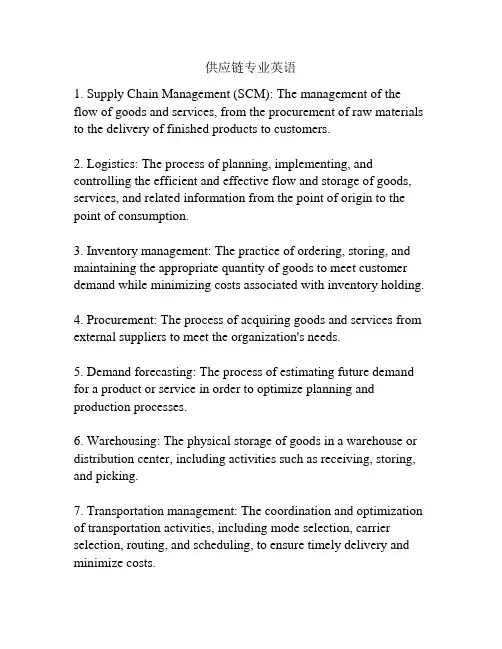
供应链专业英语1. Supply Chain Management (SCM): The management of the flow of goods and services, from the procurement of raw materials to the delivery of finished products to customers.2. Logistics: The process of planning, implementing, and controlling the efficient and effective flow and storage of goods, services, and related information from the point of origin to the point of consumption.3. Inventory management: The practice of ordering, storing, and maintaining the appropriate quantity of goods to meet customer demand while minimizing costs associated with inventory holding.4. Procurement: The process of acquiring goods and services from external suppliers to meet the organization's needs.5. Demand forecasting: The process of estimating future demand for a product or service in order to optimize planning and production processes.6. Warehousing: The physical storage of goods in a warehouse or distribution center, including activities such as receiving, storing, and picking.7. Transportation management: The coordination and optimization of transportation activities, including mode selection, carrier selection, routing, and scheduling, to ensure timely delivery and minimize costs.8. Reverse logistics: The management of the flow of goods from the point of consumption back to the point of origin, including activities such as returns, repairs, and recycling.9. Supply chain risk management: The identification, assessment, and mitigation of risks that could disrupt the smooth flow of goods and services within the supply chain.10. Lean manufacturing: An approach to production that aims to minimize waste and maximize efficiency by eliminating non-value-added activities and continuously improving processes.11. Just-in-time (JIT) inventory management: A strategy that aims to minimize inventory holding costs by ordering and receiving materials just in time for production or customer delivery.12. Total Quality Management (TQM): A management approach that focuses on continuous improvement of processes and products to meet or exceed customer expectations.13. Supply chain collaboration: The practice of sharing information, resources, and expertise among supply chain partners to optimize overall performance and achieve mutual benefits. 14. Vendor managed inventory (VMI): An agreement between a supplier and a customer in which the supplier is responsible for managing and replenishing the customer's inventory.15. Electronic Data Interchange (EDI): The electronic exchange of business documents, such as purchase orders and invoices,between trading partners to improve the efficiency and accuracy of communications.。
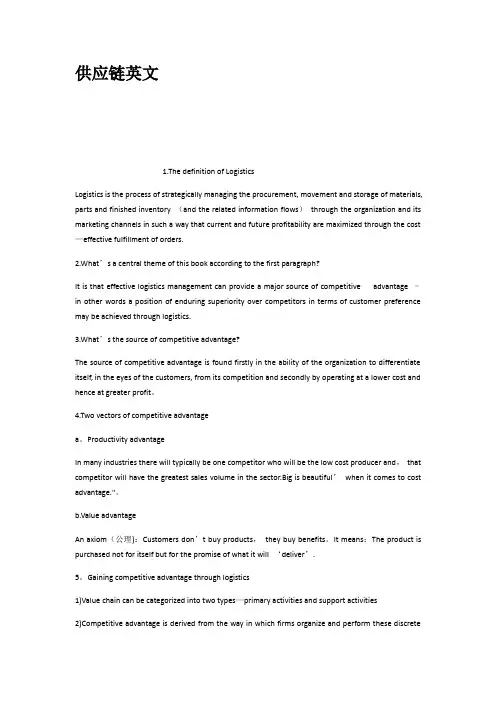
供应链英文1.The definition of LogisticsLogistics is the process of strategically managing the procurement, movement and storage of materials, parts and finished inventory (and the related information flows)through the organization and its marketing channels in such a way that current and future profitability are maximized through the cost —effective fulfillment of orders.2.What’s a central theme of this book according to the first paragraph?It is that effective logistics management can provide a major source of competitive advantage –in other words a position of enduring superiority over competitors in terms of customer preference may be achieved through logistics.3.What’s the source of competitive advantage?The source of competitive advantage is found firstly in the ability of the organization to differentiate itself, in the eyes of the customers, from its competition and secondly by operating at a lower cost and hence at greater profit。
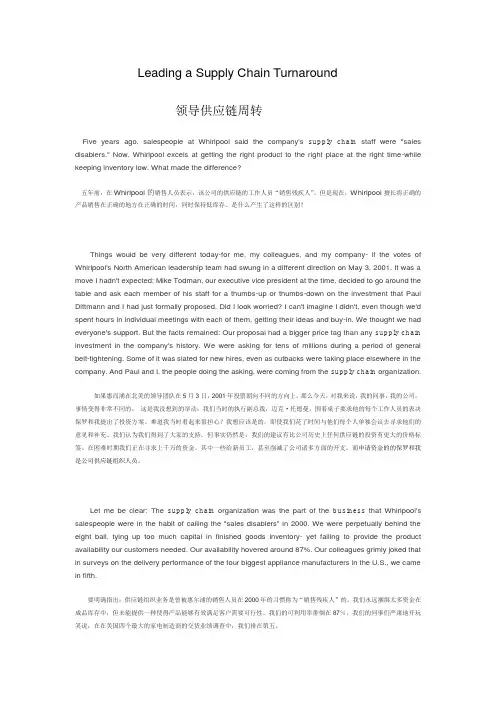
Leading a Supply Chain Turnaround领导供应链周转Five years ago, salespeople at Whirlpool said the company's supply chain staff were "sales disablers." Now, Whirlpool excels at getting the right product to the right place at the right time-while keeping inventory low. What made the difference?五年前,在Whirlpool的销售人员表示,该公司的供应链的工作人员“销售残疾人”。
但是现在,Whirlpool擅长将正确的产品销售在正确的地方在正确的时间,同时保持低库存。
是什么产生了这样的区别?Things would be very different today-for me, my colleagues, and my company- if the votes of Whirlpool's North American leadership team had swung in a different direction on May 3, 2001. It was a move I hadn't expected; Mike Todman, our executive vice president at the time, decided to go around the table and ask each member of his staff for a thumbs-up or thumbs-down on the investment that Paul Dittmann and I had just formally proposed. Did I look worried? I can't imagine I didn't, even though we'd spent hours in individual meetings with each of them, getting their ideas and buy-in. We thought we had everyone's support. But the facts remained: Our proposal had a bigger price tag than any supply chain investment in the company's history. We were asking for tens of millions during a period of general belt-tightening. Some of it was slated for new hires, even as cutbacks were taking place elsewhere in the company. And Paul and I, the people doing the asking, were coming from the supply chain organization.如果惠而浦在北美的领导团队在5月3日,2001年投票朝向不同的方向上,那么今天,对我来说,我的同事,我的公司,事情变得非常不同的。
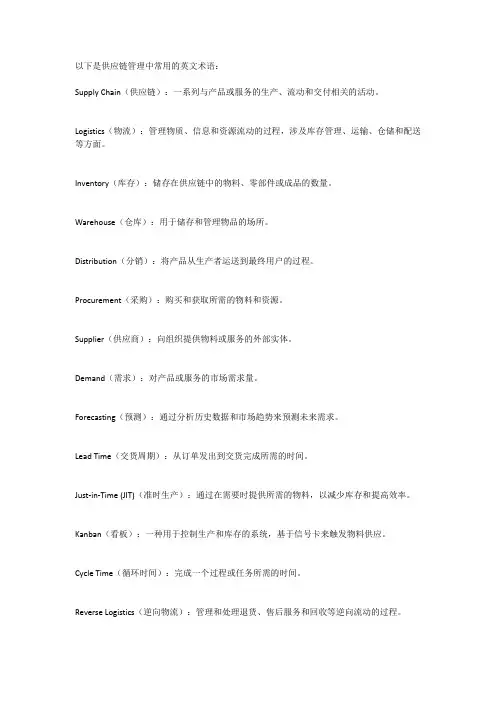
以下是供应链管理中常用的英文术语:Supply Chain(供应链):一系列与产品或服务的生产、流动和交付相关的活动。
Logistics(物流):管理物质、信息和资源流动的过程,涉及库存管理、运输、仓储和配送等方面。
Inventory(库存):储存在供应链中的物料、零部件或成品的数量。
Warehouse(仓库):用于储存和管理物品的场所。
Distribution(分销):将产品从生产者运送到最终用户的过程。
Procurement(采购):购买和获取所需的物料和资源。
Supplier(供应商):向组织提供物料或服务的外部实体。
Demand(需求):对产品或服务的市场需求量。
Forecasting(预测):通过分析历史数据和市场趋势来预测未来需求。
Lead Time(交货周期):从订单发出到交货完成所需的时间。
Just-in-Time (JIT)(准时生产):通过在需要时提供所需的物料,以减少库存和提高效率。
Kanban(看板):一种用于控制生产和库存的系统,基于信号卡来触发物料供应。
Cycle Time(循环时间):完成一个过程或任务所需的时间。
Reverse Logistics(逆向物流):管理和处理退货、售后服务和回收等逆向流动的过程。
Key Performance Indicators (KPIs)(关键绩效指标):用于衡量和评估供应链绩效的指标,如库存周转率、交货准时率等。
Continuous Improvement(持续改进):通过不断优化和改进供应链流程,以提高效率和质量。
Service Level(服务水平):衡量供应链能够按时满足客户需求的程度。
Cost-to-Serve(服务成本):为满足客户需求所需的成本,包括运输、库存和其他服务成本。
以上是供应链管理中常用的英文术语,可以帮助您更好地理解和沟通供应链相关的概念和流程。
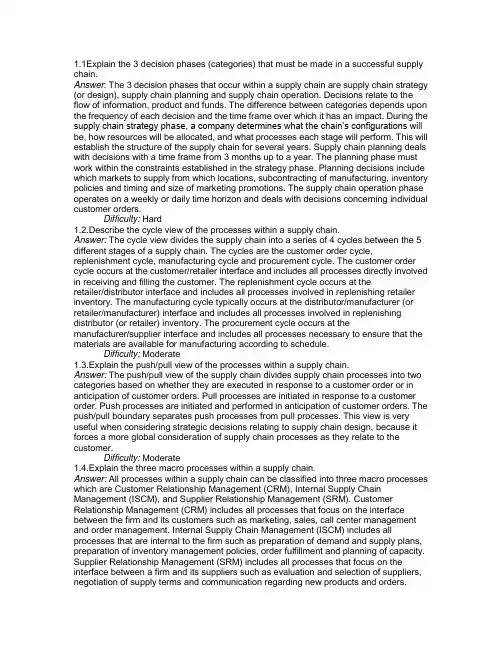
1.1Explain the 3 decision phases (categories) that must be made in a successful supply chain.Answer: The 3 decision phases that occur within a supply chain are supply chain strategy (or design), supply chain planning and supply chain operation. Decisions relate to the flow of information, product and funds. The difference between categories depends upon the frequency of each decision and the time frame over which it has an impact. During the supply chain strategy phase, a company determines what the chain’s configurations will be, how resources will be allocated, and what processes each stage will perform. This will establish the structure of the supply chain for several years. Supply chain planning deals with decisions with a time frame from 3 months up to a year. The planning phase must work within the constraints established in the strategy phase. Planning decisions include which markets to supply from which locations, subcontracting of manufacturing, inventory policies and timing and size of marketing promotions. The supply chain operation phase operates on a weekly or daily time horizon and deals with decisions concerning individual customer orders.Difficulty: Hard1.2.Describe the cycle view of the processes within a supply chain.Answer: The cycle view divides the supply chain into a series of 4 cycles between the 5 different stages of a supply chain. The cycles are the customer order cycle, replenishment cycle, manufacturing cycle and procurement cycle. The customer order cycle occurs at the customer/retailer interface and includes all processes directly involved in receiving and filling the customer. The replenishment cycle occurs at theretailer/distributor interface and includes all processes involved in replenishing retailer inventory. The manufacturing cycle typically occurs at the distributor/manufacturer (or retailer/manufacturer) interface and includes all processes involved in replenishing distributor (or retailer) inventory. The procurement cycle occurs at themanufacturer/supplier interface and includes all processes necessary to ensure that the materials are available for manufacturing according to schedule.Difficulty: Moderate1.3.Explain the push/pull view of the processes within a supply chain.Answer: The push/pull view of the supply chain divides supply chain processes into two categories based on whether they are executed in response to a customer order or in anticipation of customer orders. Pull processes are initiated in response to a customer order. Push processes are initiated and performed in anticipation of customer orders. The push/pull boundary separates push processes from pull processes. This view is very useful when considering strategic decisions relating to supply chain design, because it forces a more global consideration of supply chain processes as they relate to the customer.Difficulty: Moderate1.4.Explain the three macro processes within a supply chain.Answer: All processes within a supply chain can be classified into three macro processes which are Customer Relationship Management (CRM), Internal Supply Chain Management (ISCM), and Supplier Relationship Management (SRM). Customer Relationship Management (CRM) includes all processes that focus on the interface between the firm and its customers such as marketing, sales, call center management and order management. Internal Supply Chain Management (ISCM) includes all processes that are internal to the firm such as preparation of demand and supply plans, preparation of inventory management policies, order fulfillment and planning of capacity. Supplier Relationship Management (SRM) includes all processes that focus on the interface between a firm and its suppliers such as evaluation and selection of suppliers, negotiation of supply terms and communication regarding new products and orders.Difficulty: Moderate1.5.Explain why supply chain flows are important.Answer: Supply chain flows are important, because there is a close connection between the design and management of supply chain flows (product, information, and cash) and the success of a supply chain. The success of many companies can be directly traced to the design and management of an appropriate supply chain. The failure of many businesses can be linked directly to their inability to effectively design and manage supply chain flows.Difficulty: Moderate2.1.Discuss the two keys to the success or failure of a company.Answer: A company’s success or failure is thus closely linked to the following keys:1. The competitive strategy and all functional strategies must fit together to form acoordinated overall strategy. Each functional strategy must support otherfunctional strategies and help a firm reach its competitive strategy goal.2. The different functions in a company must appropriately structure theirprocesses and resources to be able to execute these strategies successfully.Difficulty: Hard2.2.List and explain the three basic steps to achieving strategic fit.Answer: There are three basic steps to achieving strategic fit:1. Understanding the customer and supply chain uncertaint y. First a companymust understand the customer needs for each targeted segment and theuncertainty the supply chain faces in satisfying these needs. These needs helpthe company define the desired cost and service requirements. The supply chain uncertainty helps the company identify the extent of disruption and delay thesupply chain must be prepared for.2. Understanding the supply chain capabilities. There are many types of supplychains, each of which is designed to perform different tasks well. A company must understand what its supply chain is designed to do well.3. Achieving strategic fit. If a mismatch exists between what the supply chain doesparticularly well and the desired customer needs, the company will either need to restructure the supply chain to support the competitive strategy or alter itsstrategy.Difficulty: Moderate2.3.List the attributes along which customer demand from different segments can vary. Answer: In general, customer demand from different segments may vary along several attributes as follows:•The quantity of the product needed in each lot•The response time that customers are willing to tolerate•The variety of products needed•The service level required•The price of the product•The desired rate of innovation in the productDifficulty: Moderate2.4.List the abilities included in supply chain responsiveness.Answer: Supply chain responsiveness includes a supply chain’s ability to do the following:•Respond to wide ranges of quantities demanded•Meet short lead times•Handle a large variety of products•Build highly innovative products•Meet a very high service level•Handle supply uncertaintyDifficulty: Moderate3.1.List and define the four major drivers of supply chain performance.Answer: Facilities are the places in the supply chain network where product is stored, assembled, or fabricated. The two major types of facilities are production sites and storage sites.Inventory is all raw materials, work in process, and finished goods within a supply chain. Inventory is an important supply chain driver because changing inventory policies can dramatically alter the supply chain’s efficiency and responsiveness.Transportation entails moving inventory from point to point in the supply chain. Transportation can take the form of many combinations of modes and routes. Information consists of data and analysis concerning facilities, inventory, transportation, and customers throughout the supply chain. Information is potentially the biggest driver of performance in the supply chain as it directly affects each of the other drivers.Difficulty: Moderate3.2. Explain the basic trade-off between responsiveness and efficiency for each of the major drivers of supply chain performance.Answer: The fundamental trade-off when making facilities decisions is between the cost of the number, location, and type of facilities (efficiency) and the level of responsiveness that these facilities provide the company’s customers.The fundamental trade-off when making inventory decisions is between responsiveness and efficiency. Increasing inventory will generally make the supply chain more responsive to the customer. This choice, however, comes at a cost as the added inventory decreases efficiency. Therefore, a supply chain manager can use inventory as one of the drivers for reaching the level of responsiveness and efficiency the competitive strategy targets.The fundamental trade-off for transportation is between the cost of transporting a given product (efficiency) and the speed with which that product is transported (responsiveness). The transportation choice influences other drivers such as inventory and facilities. When supply chain managers think about making transportation decisions, they frame the decision in terms of this trade-off.Good information systems can help a firm improve both its responsiveness and efficiency. The information driver is used to improve the performance of other drivers and the use of information is based on the strategic position the other drivers support. Accurate information can help a firm improve efficiency by decreasing inventory and transportation costs. Accurate information can improve responsiveness by helping a supply chain better match supply and demand.3.3.Explain the role of each of the major drivers of supply chain performance.Answer: Facilities are the where of the supply chain if we think of inventory as what is being passed along the supply chain and transportation as how it is passed along. They are the locations to or from which the inventory is transported. Within a facility, inventory is either processed or transformed into another state (manufacturing) or it is stored before being shipped to the next stage (warehousing).Inventory exists in the supply chain because of a mismatch between supply and demand. An important role that inventory plays in the supply chain is to increase the amount of demand that can be satisfied by having product ready and available when the customer wants it. Another significant role inventory plays is to reduce cost by exploiting any economies of scale that may exist during both production and distribution. Inventory isspread throughout the supply chain from raw materials to work in process to finished goods that suppliers, manufacturers, distributors, and retailers hold.Inventory is a major source of cost in a supply chain and it has a huge impact on responsiveness. The location and quantity of inventory can move the supply chain from one end of the responsiveness spectrum to the other.Inventory also has a significant impact on the material flow time in a supply chain. Material flow time is the time that elapses between the point at which Another important area where inventory has a significant impact is throughput.Inventory and flow time are synonymous in a supply chain. Managers should use actions that lower the amount of inventory needed without increasing cost or reducing responsiveness, because reduced flow time can be a significant advantage in a supply chain.Transportation moves product between different stages in a supply chain. Like the other supply chain drivers, transportation has a large impact on both responsiveness and efficiency. Faster transportation, whether in the form of different modes of transportation or different amounts being transported, allows a supply chain to be more responsive but reduces its efficiency. The type of transportation a company uses also affects the inventory and facility locations in the supply chain.Information could be overlooked as a major supply chain driver because it does not have a physical presence. Information, however, deeply affects every part of the supply chain. Its impact is easy to underestimate as information affects a supply chain in many different ways. Information serve s as the connection between the supply chain’s various stages, allowing them to coordinate and bring about many of the benefits of maximizing total supply chain profitability. Information is also crucial to the daily operations of each stage in a supply chain. For instance, a production scheduling system uses information on demand to create a schedule that allows a factory to produce the right products in an efficient manner. A warehouse management system uses information to create visibility of the warehou se’s inventory. The company can then use this information to determine whether new orders can be filled.Difficulty: Hard3.4.Explain the role of each of the major drivers of supply chain performance in the competitive strategy.Answer: Facilities and their corresponding capacities to perform their functions are a key driver of supply chain performance in terms of responsiveness and efficiency. For example, companies can gain economies of scale when a product is manufactured or stored in only one location; this centralization increases efficiency. The cost reduction, however, comes at the expense of responsiveness, as many of a company’s customers may be located far from the production facility. The opposite is also true. Locating facilities close to customers increases the number of facilities needed and consequently reduces efficiency. If the customer demands and is willing to pay for the responsiveness that having numerous facilities adds, however, then this facilities decision helps meet the comp any’s competitive strategy goals.Inventory plays a significant role in a supply chain’s ability to support a firm’s competitive strategy. If a firm’s competitive strategy requires a very high level of responsiveness, a company can use inventory to achieve this responsiveness by locating large amounts of inventory close to the customer. Conversely, a company can also use inventory to make itself more efficient by reducing inventory through centralized stocking. The latter strategy would support a competitive strategy of being a low-cost producer. The trade-off implicit in the inventory driver is between the responsiveness that results from more inventory and the efficiency that results from less inventory.The role of transportation in a company’s competiti ve strategy figures prominently when the company is considering the target customer’s needs. If a firm’s competitive strategy targets a customer that demands a very high level of responsiveness, and that customer is willing to pay for this responsiveness, then a firm can use transportation as one driver for making the supply chain more responsive. The opposite is true as well. If a company’s competitive strategy targets customers whose main decision criterion is price, then the company can use transportation to lower the cost of the product at the expense of responsiveness. As a company may use both inventory and transportation to increase responsiveness or efficiency, the optimal decision for the company often means finding the right balance between the two.Information is a driver whose importance has grown as companies have used it to become both more efficient and more responsive. The tremendous growth of the importance of information technology is a testimony to the impact information can have on improving a company. Like all the other drivers, however, even with information, companies reach a point when they must make the trade-off between efficiency and responsiveness.Difficulty: Hard4.1.Explain the measures of customer service that are influenced by the structure of the distribution network.Answer: Response time is the time between when a customer places an order and receives delivery.Product variety is the number of different products/configurations that a customer desires from the distribution network.Availability is the probability of having a product in stock when a customer order arrives. Customer experience includes the ease with which the customer can place and receive their order. It also includes purely experiential aspects, such as the possibility of getting a cup of coffee and the value that the sales staff provides.Order visibility is the ability of the customer to track their order from placement to delivery.Returnability is the ease with which a customer can return unsatisfactory merchandise and the ability of the network to handle such returns.Difficulty: Moderate响应时间是从客户下订单到接收交付之间的时间。
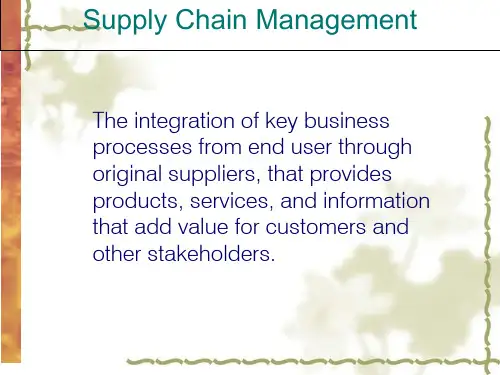
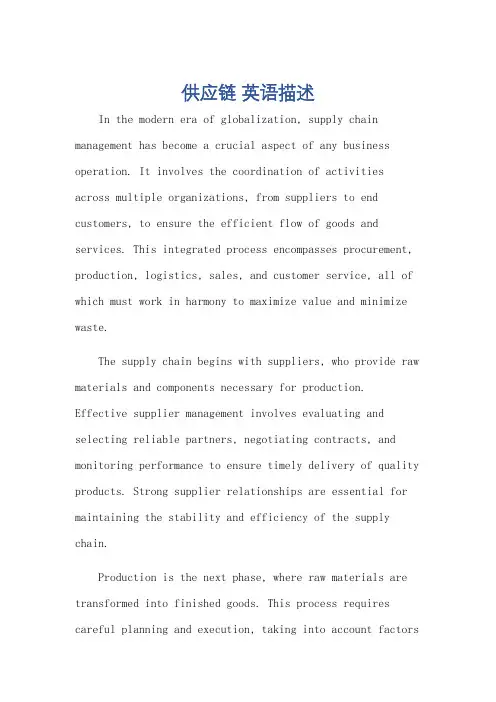
供应链英语描述In the modern era of globalization, supply chain management has become a crucial aspect of any business operation. It involves the coordination of activities across multiple organizations, from suppliers to end customers, to ensure the efficient flow of goods and services. This integrated process encompasses procurement, production, logistics, sales, and customer service, all of which must work in harmony to maximize value and minimize waste.The supply chain begins with suppliers, who provide raw materials and components necessary for production.Effective supplier management involves evaluating and selecting reliable partners, negotiating contracts, and monitoring performance to ensure timely delivery of quality products. Strong supplier relationships are essential for maintaining the stability and efficiency of the supply chain.Production is the next phase, where raw materials are transformed into finished goods. This process requires careful planning and execution, taking into account factorssuch as capacity, demand, and lead times. Effective production management ensures that products are made efficiently, cost-effectively, and to the required quality standards.Logistics, which includes transportation, warehousing, and distribution, is crucial for getting products to customers. Efficient logistics systems minimize transportation costs, reduce inventory holding costs, and ensure timely delivery. The use of advanced technologies like just-in-time delivery, lean logistics, and supply chain analytics can further optimize the logistics process. Sales and customer service are the final links in the supply chain, where businesses engage directly with customers. Effective sales and customer service strategies enhance customer satisfaction and loyalty, driving revenue growth and profitability. A responsive customer service team can also help identify and address issues in the supply chain, improving overall performance.In today's dynamic business environment, supply chain management must be agile and responsive to changes in demand, supply, and market conditions. The integration ofadvanced technologies like artificial intelligence, blockchain, and the Internet of Things is transforming supply chain management, enabling real-time tracking and tracing, predictive analytics, and improved decision-making. However, supply chain management also faces challenges such as risks associated with supplier failure, natural disasters, and geopolitical events. Effective risk management strategies, including diversification of suppliers, contingency planning, and resilience building, are crucial for mitigating these risks and ensuring the continuity of the supply chain.In conclusion, supply chain management is a complex yet critical aspect of modern business operations. It requiresa holistic approach, encompassing all stages of the supply chain from suppliers to customers. By leveraging advanced technologies and implementing effective risk management strategies, businesses can optimize their supply chains, drive growth, and enhance customer satisfaction in a globalized world.**供应链管理:全球视角**在全球化的现代时代,供应链管理已成为任何业务运营的关键方面。
ABC clasification ABC分类Acceptable Quality Level 允许水准Accessory 附件Action Report 行动报告Add/Delete BOM 增删材料表Aggregate Planning总体规划Agile Manufacturing 灵活制造Allocated Inventory 保留量Allowance 宽放Alternate BOM 替代材料表American Production and Inventory Control Society 美国产业管理学会Anticipation Inventory 预期库存Assemble to Order 定单组装Automation 自动化Autonomation 自主化Available Inventory 可用库存Available to Promise 可答应量BackFlush 倒冲入账Backlog 待交货Back Order 逾期定单Bill of Labor 人力表Bill of Material 材料表bill of resources 资源表BOM Code 材料表码Bom Explosion 材料表展开Bom Implosion 材料表逆展Bom Structure 材料表结构Budgeted Capacity 预算产量Built-on-the-line parts 线上生产零件Bulk Issue 大批发料Bullwhip Effect 长鞭效应Business Plan 事业计划Business Process Reengineering 企业程序再造Capacity 产量Capacity Control 产量控制Capacity requirement planning产量需求规划Check-in 结入Check-Out 结出Client/ Server Architecture 主从式架构Common part Bom 共享件材料表Computer aided design system 计算机辅助设计系统connected flow 相连材料流consolidated freight 合并货运constraint management 限制因素管理continuous improvement 连续改善continuous production 连续式生产critical capacity 关键产量critical part 关键零件customer order 客户定单customization 客制化customer service level 顾客服务水准cycle count interval 周期盘点区间cycle counting 周期盘点cycle time 周期时间customer relationship management 客户关系管理data flow diagram 数据流程图de-coupling stock 反耦合库存Demand Management 需求管理Demand Rate 需求速率Demand time fence 需求时栅demonstrated capacity 验证产量dependent demand 依赖需求diagnostic test 诊断测试disconnected flow 分离材料流iscret manufacturing 装配式生产distribution center 配销中心distribution requirement planning配销需求规划drum-buffer-rope control DBR管制法earliest start date 最早开工日economic order quantity 经济订购量economic part period 经济量期elimination,combination,rearrangement,simplification ECRS改善法emergency kanban 紧急看板employee empowerment 员工授权employee involvement 员工参与end user computing 使用者自建系统engineering to order 定单设计engineering change 设计变更engineering product structure 工程用产品结构表exception report 企业资料规划enterprise resource planning例外报告executive information system 主管信息系统existence test 存在测试expeditor 催料人员final assembly schedule 最终组装排程finished goods 完成品firm planned order 固定计划定单first in first out 先进先出fixed order quantity 定量批量法flow shop 流程生产工厂forecast 预测forecast horizon预测期间fundamental data 基本资料gateway workstation 投料工作站graphic user interface 图形接口gross requirement 总需求group technology 群组技术hedge inventory 避险库存inbound queue control 输入端队列控制independent demand 独立需求input/output control 输入/输出控制intermittent production 间歇式生产inventory management 库存管理inventory status 库存状态inventory sub-type 库存副型态inventory type 库存型态item 材料(项目)item master 材料主档job 工件,工作job shop 工件生产工厂joint operation 联合作业just in time 及时供补kanban 看板kanban ceiling 看板界限latest start date 最晚开工日lead time 前置时间lead time offset 前置时间冲销least total cost 最低总成本批量法least unit cost 最低单位成本批量法level scheduling 平准化排程level production(linearity) 平准化生产linearity 定率生产load 负荷look ahead/look back 瞻前顾后法lot for lot 逐批批量法lot number 批号lot size 批量lot size inventory 批量库存lot sizing rule 批量法则low-level code 最低阶码maintenance, repair and operational supplies 间接物料make to order 定单生产make to stock 计划生产managerial product structure 管理用产品结构表manufacturing bom 制造单元manufacturing cell 制令单manufacturing order 制造规划与控制manufacturing planning and control 制造资源规划master production scheduling 主生产排程master scheduler 主生产排程员material service sheduling 主服务排程material handling 材料搬运material requirement planning材料需求规划(计划) mean absolute deviation 平均绝对差modular bom 模块材料表modular production 模块化生产mps item MPS 项目mrp crusades MRP 改革运动mrp nervousness MRP不安定性multilevel mps 多阶主生产排程net change 净变法net requirement 净需求offset time 冲销时间one less at a time 一次减一点on-hand inventory 在库量on-order inventory 在途量open system platform 开放系统平台operations planning and control 作业规划与管制operations process chart 作业程序图option 选用件optional bom 选用材料件order interval 订购区间order point 订购点original equipment manuafacturer 原设备制造商outbound queue control 输出端队列控制overflow stockroom 溢量仓parent/component 父件/子件part number 件号part periodic balancing 量期平衡批量法past due 逾期量peg file 溯源文件pegging 溯源period length 期长periodic order quantity 定期批量法periodic review system 定期评估法phantom 幽灵材料phantom bom 幽灵材料表phantom component 幽灵子件picking order 领料单pipeline stock 管路库存plan-do-check-action cycle 计划-执行-检查-行动循环planned order receipts 计划定单收料planned order releases 计划定单发出planning bom 计划材料表planning horizon计划期间planning time fence 计划时栅point of use 使用点primary stockroom 基本仓priority control 优先次序控制priority planning优先次序规划preventive maintenance 预防性维护process flow chart 制程流程图process manufacturing 流程式生产product configuration system 产品构造系统product family 产品族product line 产品线product load profile 产品负荷表product structure 产品结构表product sub-line 产品副线production activity control 生产活动管制production rate 生产速率production plan 生产计划production planning生产规划production run 生产连project-based production 项目式生产projected available balance 预计可用量projected on-hand 预计在库量pseuo bom 假材料表pull signal 拉式讯号pull system 拉式系统purchase order 订购单purchase reuisition 请购单quantity-per 单位用量quick response 快速反应rated capacity 评估产量raw material 原材料reasonableness test 合理测试receiving order 收料单refill kanban 补充看板regeneration 再生法re-order point 再订购点法repetitive manufacturing 重复性生产replacement part 替代件replenishment plan 补充计划replenishment time 补充时间resource profile 资源负荷表resource requirement planning资源需求规划rework kanban 重加工看板rolling kanban 滚动看板rolling schedule 滚动式排程rough-cut capacity planning粗略产量规划route 途程routing 途程表safety stock 安全存量safety time 安全时间safety order 销售定单scheduled receipts 在途量(已订未交量) scarp rate 报废率secondary stockroom 次级仓semi-finished goods 半成品serial number 序号setup 准备作业shop calendar 厂历shop floor 制造现场shop floor control 制造现场控制shop order 制令单significant numbering 显义编号standard coefficient 标准系数stock keeping unit 材料库存单位subsontract order 外包单super bom 超材料单supply chain management 供应链管理synchronized control 同步控制synchronized production 同步生产theoretical capacity 理论产量theory of constraints 限制理论three tier architecture 三层式架构throughtput 产出率time bucket 时段time phased order point 分期间订购点法transferring order 调拨单transportation inventory 运输库存total employee involvement 全员参与total preventive maintenance 全面预防性维护total productive maintenance 全面生产性维护total quality management 全面质量管理two bin system 双箱法two level mps 双阶主生产排程unit of measure 单位visual review system 目视评估法where-used report 用途表WIP inventory 在制品库存WIP tracking 在制品追踪work flow control system 工作流程控制系统work-in-process 在制品yield 良品率Common Terms in Newspapers :accredited journalist n. 特派记者advertisement n.广告.advance n.预发消息;预写消息affair n.桃色新闻;绯闻anecdote n.趣闻轶事assignment n.采写任务attribution n. 消息出处,消息来源back alley news n. 小道消息backgrounding n.新闻背景Bad news travels quickly. 坏事传千里。
供应链术语大全1、activity-based costing(ABC)基于活动的成本计算。
一种成本计算技术,把简介成本细分到每一个生产活动中,是简介成本和直接成本相互对应以更好的评估生成每一个产品的真实成本。
2、advance shipping notice(ASN)预先运送通知。
供应商向客户发出的,说明订单发运时间的文书。
ASNs 通常以电子方式传输。
3、advanced planning and scheduling system(APS)高级计划与排程系统。
一系列高级应用然间,运用数学模型和相关的技术为复杂的生产和供应问题找出优化解决方案。
4、aggregate forecast综合预测。
一种根据产品或客户资料的同类特性把他们归类而达成的综合预测方案5、Aggregation集合。
把相近的产品或顾客归类聚合,以简化计划的制定,并取得更稳定的预测结果的方法6、assemble-to-order strategy订单组装策略。
一种将产品部件在需求之前提前完成,把最后组装工作延迟到需求落实后才进行的库存策略7、available to promise(ATP)有效承诺。
产品库存状况的一种,指有足够的库存并能够马上发货的订单执行能力。
8、back scheduling逆向排程。
一种工作排程方法,从计划完成的日期开始,将需要执行的工作任务按由后向前逆推的顺序来进行工作计划安排。
9、Backhaul回程运输。
指车辆回程运载的货物,以充分地利用返程的货运能力。
10、bill of lading装货单。
发货文件,它列出了这批货物中所装在的具体产品,并且陈述了运输的条件。
11、bill of materials(BOM)材料清单。
一份列出组成产品所需要的零配件和原料的清单,并且按照产品的零件、组件和中间件的形成构成等级结构。
12、bill of operations(BOO)作业列表。
一个列表,列出完成一种产品生产所需要的作业步骤,并且按照各个步骤执行的顺序形成一个等级的结构图。
供应链常用英语表达供应链(Supply Chain)是指从原材料的采购、运输、加工、生产到销售的一系列过程,包括原材料采购、零部件加工、生产制造、物流配送、销售和售后服务等环节。
供应链管理(Supply Chain Management,SCM)则是指对整个供应链进行计划、协调、执行和控制的过程。
以下是一些供应链中的常用英语表达:Supplier 供应商:提供原材料、零部件或服务的公司或个人。
Vendor 销售商:将产品或服务销售给最终用户的公司或个人。
Logistics 物流:与运输、储存和配送相关的活动。
Inventory 库存:公司持有的原材料、在制品和成品数量。
Just-in-time delivery 准时制交付:在需要时立即交付原材料或零部件。
Just-in-case inventory 备货:为了应对不确定情况而持有的库存。
Lead time 提前期:从订单发出到产品或服务交付所需的时间。
Transportation 运输:将产品或服务从一地运往另一地的过程。
Distribution 分销:将产品或服务从制造商运送到销售商或最终用户的过程。
Procurement 采购:购买原材料、零部件或服务的过程。
Manufacturing 制造:将原材料加工成成品的过程。
Assembly line 组装线:将零部件组装成完整产品的生产线。
Warehouse 仓库:储存原材料、在制品和成品的地方。
Inventory control 库存控制:管理库存数量和库存位置的过程。
Reorder point 再订购点:库存降至一定水平时需要重新订购产品或服务的点。
以上是一些供应链中的常用英语表达,希望对您有所帮助。